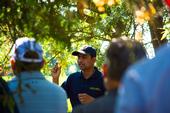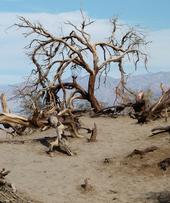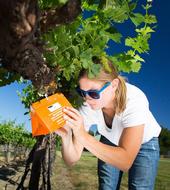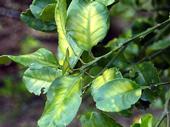- (Focus Area) Pest Management
- Author: Jeannette E. Warnert

Last May, a Turlock almond grower noticed nearly all the nuts on a row of trees in his orchard had fallen to the ground.
“It looked like we shook this row,” he said. “I was scared. I thought the whole orchard was going to go.”
He called UC Cooperative Extension.
UCCE Integrated Pest Management advisor Jhalendra Rijal, who serves Stanislaus, San Joaquin and Merced counties, determined the cause was an infestation of brown marmorated...
- Author: Tunyalee A. Martin

The University of California Statewide Integrated Pest Management Program (UC IPM) is celebrating its 40th anniversary. Established July 1, 1979, with funding from the California Legislature, UC IPM built upon a growing movement to reduce dependence on pesticides. Drawing on expertise across the University of California system, UC IPM develops and distributes UC's best information on managing pests using safe and effective practices that protect people and the environment.
Over the years, UC IPM expanded its efforts beyond agriculture to include
- Author: Jeannette E. Warnert

When insects, weeds, animals and diseases enter California from elsewhere in the nation or world, they can cause economic losses to agricultural crops and ecological damage to the state's natural areas. Ultimately, invasive species affect every resident of California.
Based on historical data, a new invertebrate species establishes itself in California about every six weeks, on average. They don't all become serious pest problems, but many evade eradication efforts, disrupt carefully balanced integrated pest management programs, hijack sensitive ecosystems, and spoil valued recreational resources and urban landscapes.
UC Agriculture and Natural Resources joins the California Department of Fish and Wildlife and the...
- Author: Jeannette E. Warnert

The UC Integrated Pest Management Program and the Center for Invasive Species Research are two UC Agriculture and Natural Resources programs that monitor invasive species and coordinate responses when they become established in the state. They work closely with UC ANR advisors and specialists, government agencies and nonprofit organizations on eradication, management and prevention of these threats.
At an invasive species summit last year in Sacramento, UC ANR vice president Glenda Humiston and California Department of Food and Agriculture secretary Karen Ross convened scientists,...
- Author: Jeannette E. Warnert

Huanglongbing (HLB) is a devastating bacterial disease of citrus that is starting to spread rapidly in urban areas of Southern California. The disease is spread by the invasive insect Asian citrus psyllid.
Asian citrus psyllid was first identified in California in 2008, and has been found from San Diego and Imperial counties in the south, all the way to Sacramento County in the north. See a map of Asian citrus psyllid and huanglongbing distribution in California.
UC Agriculture and Natural Resources specialists and advisors are working with the citrus industry, USDA and CDFA to control ACP populations and keep HLB...



